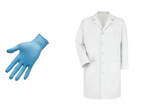|
Formula
Procedure of Application
Development Complete When
Source of Error
Incompatibilities
Precautions
Storage Container
Safety
Recommendations
Similar Reagent
Sequential Reagents
Formula
Solution #1: 4 g Choline chloride 8 ml Tergitol 7 500ml distilled water & Stir Solution #2: 10 g molybdenum disulfide 50 ml of solution #1 & Stir Solution #3: Add 900 ml distilled water to solution #2 & Stir. -- or -- (Combine the following into a suspension:) 0.4 ml Tergitol (detergent) 5 g Molybdenum disulfide 50 ml distilled water Procedure of Application
1. a) Tray immersion - keep stationary for 1 minute. - or - b) Squeegee bottle application - Shake well and apply. Repeat for 1 minute. 2. a) Tray rinse excess reagent in tap water for 15 seconds. - or - b) Tap water rinse under running water for 15 seconds. 3. Allow the item to dry at room temperature. 4. Photograph any developed detail, then you may try lifting the dried print. Development Complete When
Repeated applications no longer produce ridge detail development or enhancement. Source of Error
Keep agitating the S.P.R. solution when applied as a spray technique. Do NOT agitate the S.P.R. reagent when applied as a tray immersion technique. S.P.R. is less effective on items that have dried after being wet. Incompatibilities
Porous surfaces and items that disintegrate in water solutions. Items that cannot be effectively rinsed of the working solution. Precautions
Check with Questioned Document Unit before processing items bearing written material. This procedure is messy. The dried reagent is difficult to wash or remove. Storage Container
Dark or Clear stoppered plastic bottles. Safety
No real health problems, although it is wise to wear safety goggles during processing and to avoid prolonged skin contact with the reagent. Recommendations
Recommended in wet conditions of falling rain or snow. This reagent can effectively work on items which have been soaked in liquid accelerants. Completely immersing the item in a tray of the reagent is more effective than squirt or spray applications. Similar Reagent
Sequential Reagents
Vertical Divider
|
Chemical Name
Small Particle Reagent Surface Used On Non-Porous Surfaces. Effective for use on wet items Sensitive To Sebaceous lipds & Fatty Components Abridged Reagent Sequence
Vertical Divider
|
Ridge Detail Visualized by:
Visible chemical/stain reaction Reagent Applicabilities: Non-Porous Surfaces Post Cyanoacrylate Wet Surfaces Other Chemical Name(s): S.P.R. Molybdenum disulfide Molybdenum disulphide Working Solution Shelf-life: Indefinite |
Process Summary:
A reagent for latent print processing of items which are wet when recovered. Suggested for use on items where latent print powders are ineffective. This reagent can effectively work on items which have been soaked in liquid accelerants. The active ingredient (Molybdenum disulfide), which is applied either by spray or dipping. This technique requires a large work area that will be subject to messy conditions.
A reagent for latent print processing of items which are wet when recovered. Suggested for use on items where latent print powders are ineffective. This reagent can effectively work on items which have been soaked in liquid accelerants. The active ingredient (Molybdenum disulfide), which is applied either by spray or dipping. This technique requires a large work area that will be subject to messy conditions.
Accepted Deviations:
S.P.R. can be used as a post-cyanoacrylate process when dye stains are ineffective. Commercial kits are available, which can develop ridge detail in black, white or Ultra-violet. Application of the reagent may be repeated to enhance any faintly-developed ridge detail. The developed ridge detail may be lifted after being photographed.
S.P.R. can be used as a post-cyanoacrylate process when dye stains are ineffective. Commercial kits are available, which can develop ridge detail in black, white or Ultra-violet. Application of the reagent may be repeated to enhance any faintly-developed ridge detail. The developed ridge detail may be lifted after being photographed.
Supporting Reference Materials:
- Minutiae Magazine, Summer Special 1994, Issue No. 24, pg.7.
- Navarro, R.L., "Chemical Enhancement of Questioned Footwear Impressions", N.C. Bureau of Investigation, 1992, Page 53.
- Advances in Fingeprint Technology 2nd. Ed., Lee, H.C. & Gaensslen, R.E., CRC Press, Boca Raton, FL., 2001.
- Manual of Fingerprint Development Techniques 2nd. Ed., Home Office - Police Scientific Development Branch, White Crescent Press, Ltd., Luton, England, 2001.
- Technical Notes, Lightning Powder Co. Inc., Salem, OR., 2001.
- Almog, Frank A., "Modified SPR for Latent Fingerprint Development on Wet, Dark Objects", Jor. Forensic Ident., Vol. 43, No. 3, 1993, pp.




